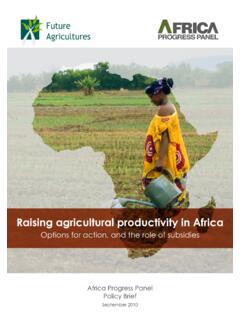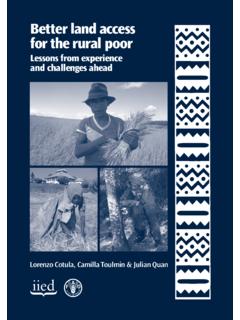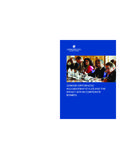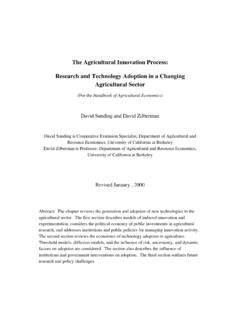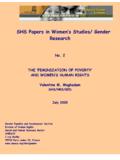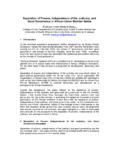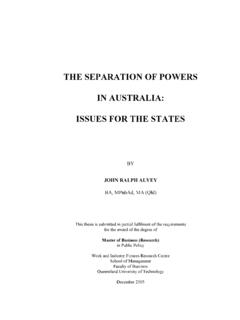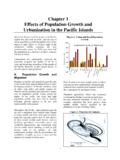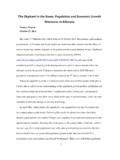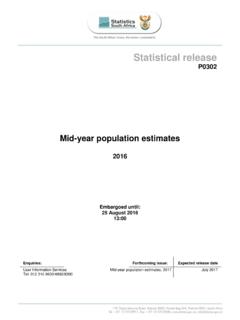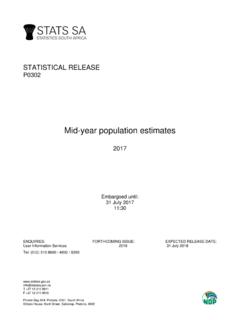Transcription of Singapore’s Changing Structure and the Policy …
1 ASIAN METACENTRE RESEARCH PAPER SERIES no. 3. Singapore's Changing Structure and the Policy Implications for Financial Security, Employment, Living Arrangements and Health Care Angelique Chan Founded 1905. ASIAN METACENTRE. FOR population AND SUSTAINABLE DEVELOPMENT ANALYSIS. HEADQUARTERS AT INSTITUTE FOR ASIAN RESEARCH. NATIONAL UNIVERSITY OF SINGAPORE. Singapore's Changing Age Structure And The Policy Implications For Financial Security, Employment, Living Arrangements, and Health Care Angelique Chan Angelique Chan is an Assistant Professor of Sociology at the National University of Singapore. She received her from the University of California, Los Angeles and completed a Postdoctoral Fellowship at the University of Michigan population Studies Center. Most of her research lies in the area of social demography.
2 She has carried out analyses of infant mortality in China and analyses of population aging in Malaysia and Singapore. Her current research focuses on comparative analyses of the social and economic consequences of population aging in Asia using survey data from the region. Contents Contents i Abstract ii List of Tables iii List of Figures iv Section 1 Introduction 1. Section 2 Singapore's Changing Age Structure 3. Section 3 Data 6. Section 4 Financial Security 7. Section 5 Employment and Employability 13. Section 6 Housing and Land Use Policies 15. Section 7 Health Care 18. Section 8 Conclusion 22. References 23. Notes 25. i Abstract T his paper discusses the issues and implications of population aging for Singapore. As one of the fastest aging populations in Asia, Singapore faces the challenge of developing public policies to accommodate this Changing age Structure .
3 This paper examines some of the social and economic consequences of this rapid shift in Singapore's age stricture. The specific areas discussed are financial security, employment, living arrangements, and health care, for Singapore elderly. Recently available panel data for Singapore (1995-1999) is used to examine the Changing needs of the elderly over time. The results show large variations in financial and health status of the elderly between the two survey periods. The panel data also reveal changes in living arrangements between 1995 and 1999, although the changes are not as dramatic as those for income. An increasing percentage of elderly persons who are not working are looking for work. This suggests that policies aimed at hiring older workers will be well received by the elderly themselves in future.
4 The results point to the need to develop policies that cater to specific sub-groups of elderly persons. The implementation of uniform policies across all ages of elderly runs the risk of neglecting needs of specific sub-groups over time. ii List of Tables Table 1 Singapore's population and growth Rate, 1871-2030 3. Table 2 Median Age for Singapore (1911-2000) 4. Table 3 Target Contribution Rates for the Various CPF Accounts (Current 8. Rates are Indicated in Brackets Below). Table 4 Total CPF Savings at Age 55 Among Elderly Who Were Aged 59 9. and Above in 1999. Table 5 Level and Change in Income: Singapore, 1995-1999 10. Table 6 Changing Levels of Perceived Income Adequacy Between 1995 11. and 1999. Table 7 Association Between Change in Actual Income and Change in 11. Perceived Income Adequacy: Singapore, 1995-1999.
5 Table 8 Employment Status of Elderly Singaporeans, 1995 and 1999 13. Table 9 Main Reason for Continuing Work After Retirement by Ethnicity, 14. 1999. Table 10 Type of Living Arrangements for Respondents Aged 59 and Above 15. in 1999. Table 11 Health Status of Elderly Singaporeans, 1995 and 1999 19. Table 12 Change in Health Status of Respondents Between 1995 and 1999 19. Table 13 Type of Ailments by Age Group for Chinese Elderly 20. Table 14 Type of Ailments by Age Group for Malay Elderly 20. Table 15 Type of Ailments by Age Group for Indian Elderly 21. iii List of Figures Figure 1 Changes in Living Arrangements Between 1995 and 1999 16. iv Section 1 Introduction T his paper discusses the implications of population aging for policies regarding old age support in Singapore. As one of the fastest aging populations in Asia, Singapore faces the challenge of developing public policies to accommodate this Changing age Structure .
6 Currently 7% of Singapore's population is over the age of 65, however, by 2030 this will increase to 19% (Inter-Ministerial Committee on Aging Report 1999). As Pool (2000) discusses in an earlier paper, age structural transitions affect supply and demand factors within a society, differentially putting pressure on key life cycle stages and consequently policies catering to the needs of populations at specific ages. In this paper I discuss the Policy implications of population aging in the areas of financial security, employment, living arrangements, and health care for Singapore elderly. I combine this discussion with recently available longitudinal data for Singapore. My focus is on the Changing needs of the elderly over time and the need for Policy makers to take these changes into account when developing policies for older adults.
7 Longitudinal data provide for more accurate projections of the Changing needs of the elderly over time (Andrews and Hermalin 2000). Given increases in life expectancy, the importance of Changing needs within the span of old age (from age 65 onwards) becomes even more pertinent. For example, housing and health care policies for the aged may have to be fine-tuned so as to cater to specific needs of young-old (65-74) versus oldest-old elderly (75+). The goal of most Asian governments is to develop programmes that do not undermine family support which is perceived as far superior to state-based support, both morally and financially (Ofstedal, Chayovan, Chan, et al. 2001). The family has traditionally been the main source of support for the elderly in Asia, and Singapore is no exception. In recent decades, academic debate has centered upon gauging the effect of modernization or industrialization on levels of familial support (Cowgill and Holmes 1972; Martin and Kinsella 1994).
8 This interest intersects with the awareness of policymakers in Asia that traditional family support of the elderly may decline in future. There is some evidence of declining levels of familial support in countries such as China and India due to the effects of massive rural-urban migration of young adults, and changes in the occupational structures (World Bank 1994). This has led some Policy makers to decry the influence of Westernization . and its by-product, individualism. However, there is also evidence to suggest that the Asian family is adapting to Changing economies and that elderly well-being is not declining. Research on intergenerational transfers in Indonesia, Malaysia, the Philippines, Singapore, Taiwan, and Thailand, has shown high-levels of intergenerational support for elderly parents either via coresidence or the transfer of goods and services (Knodel 1997a, 1997b; Hermalin 1997, Chan 1999a, 1999b.)
9 Ofstedal, Knodel and Chayovan 1999; Chang 1999). In Singapore, the government has strongly upheld the belief that familial support of the elderly is the ideal. To a certain extent, we see that there remain very high-levels of family support, as measured by coresidence rates. Approximately 85% of Singaporean elderly live with at least one The challenge for Policy makers in all of these countries is to develop sound systems to ensure economic and social well- 1. being of the elderly. This means developing a delicate mix to enhance levels of familial support while at the same time ensuring individual preparation for old age. Understanding the role of policies in ensuring old age support necessitates a recognition that there exists a politics of aging which involves the allocation of resources by age (Rappa 1999).
10 Singapore is not a welfare state and individual responsibility is the mantra underlying most, if not all, policymaking decisions. This attitude is reflected in the types of policies implemented, for example, the Central Provident Fund described later in this paper. In the following section, I review the changes that have occurred in Singapore's age Structure since Independence in 1965. I then discuss policies for financial security, employment, living arrangements, and health care, that have been developed by the Singapore Government. Where possible, I provide illustrations of the Changing characteristics of elderly Singaporeans over time, using data from a longitudinal survey carried out between 1995 and 1999. 2. Section 2 Singapore's Changing Age Structure A t present, Singapore's population stands at million, with an annual growth rate of for resident Singaporeans (Singapore Census of population 2000).
